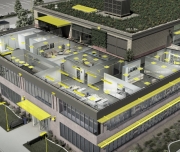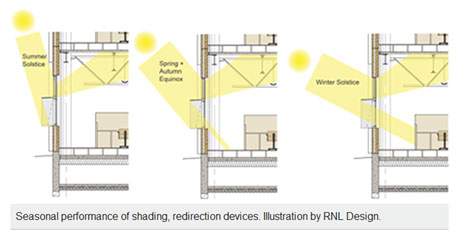Daylighting
Daylighting uses light originating from the sun as a substitute for electrical lighting. The best proven lighting strategy is to employ layers of light - using daylight for basic ambient light levels while providing occupants with additional lighting options to meet their needs.
An effective daylighting strategy appropriately illuminates the building space, through side-lighting and top-lighting apertures such as windows and skylights, without subjecting occupants to glare or major variations in lighting levels. Daylight can be reflected into the interior of the space using light shelves at the building’s perimeter or light tubes from the roof. Daylighting can reduce energy consumption from lighting and provide a visually stimulating and productive environment for occupants.
Daylighting Analysis
A critical first step to optimizing the benefits of daylight, including to occupants’ circadian rhythms, is understanding daylighting conditions. A daylighting analysis is a simulation of daylight levels within a space at various times of the day and year and can inform the placement and size of windows and skylights in new construction projects, as well as the treatment of windows, use of space, design of electric lighting systems, placement of furniture and selection of colors and finishes in any project. A daylighting analysis using lighting simulation software can simulate daylight illuminance levels and patterns, model how to integrate electric lighting based on available daylight, identify when and where glare may need to be controlled, and estimate energy savings. Daylighting analyses are best conducted by a professional lighting consultant as early as possible in the design process.
Integrating Daylighting with Electric Lighting and Controls
Daylight-responsive lighting controls are an essential component of any daylighting strategy. Photosensor controls that adjust the level of electric lighting according to the amount of daylight available will yield the greatest benefit. Switching controls turn some or all of the electric lighting off when there is sufficient daylight. Dimming controls modulate the electric lighting depending on the available level of daylight.
Operation and Maintenance
Key to the success of an effective daylighting strategy is the education and engagement of occupants and operations and maintenance personnel. Commissioning is important to ensure that the daylighting controls and electric lighting are properly installed and configured. Occupants should be educated about acceptable levels and benefits of daylight and the features of the daylighting strategy. This not only contributes to occupant comfort but empowers occupants to be advocates for the proper operation of the lighting system and controls. Operations and maintenance personnel must be educated about all aspects and components of the daylighting strategy and how to continually evaluate the system’s performance, as well as trained on the functionality and maintenance requirements of the electric lighting and controls.
Bundles:
Optimize Occupant Comfort
Optimize Occupant Comfort
Optimize Daylighting
Lighting and Occupant Education and Engagement
System Relationships
HVAC
Minimize heating and cooling loads by considering climate conditions, glazing selection, and the placement of windows and skylights. Poorly implemented daylighting techniques can lead to overheating of a space and an increase in cooling loads.
Reflective coatings on windows can reduce heat gain in the summer.
Glass has a lower insulation value than other building components, allowing a higher rate of heat transfer to the outdoors. Be sure to specify windows with higher insulation values, which may include those with double- or triple-paned glass.
Windows and skylights with integral blinds or shades offer some maintenance benefits but can cost more and may have a lower insulation value.
IEQ
Optimized daylighting and access to quality views to the outdoors can contribute to occupant satisfaction and psychological comfort which may enhance occupant performance and reduce absenteeism in some circumstances. Allowing daylight into the space while simultaneously providing individualization and acoustical privacy can be accomplished with partially translucent interior walls.
Provide occupants seated near windows glare control integrated into the daylighting strategy.
![]() .
.

